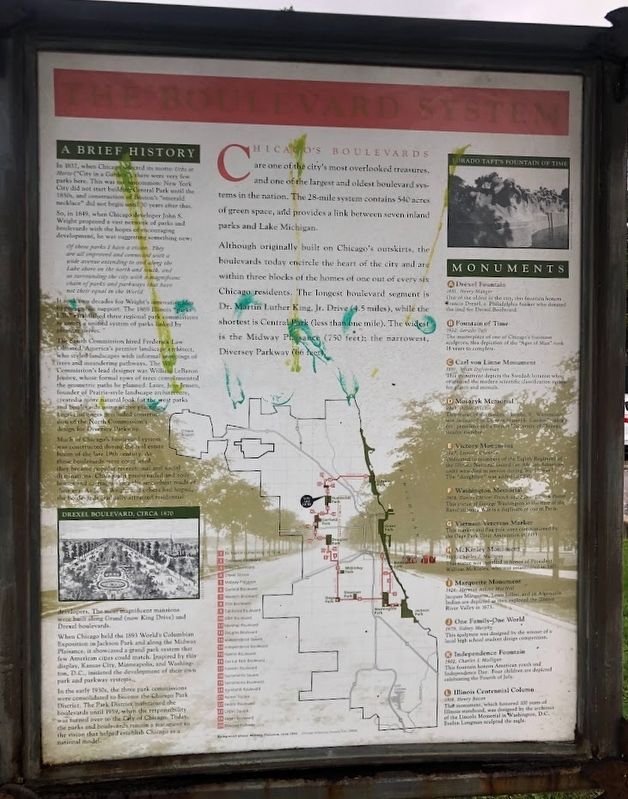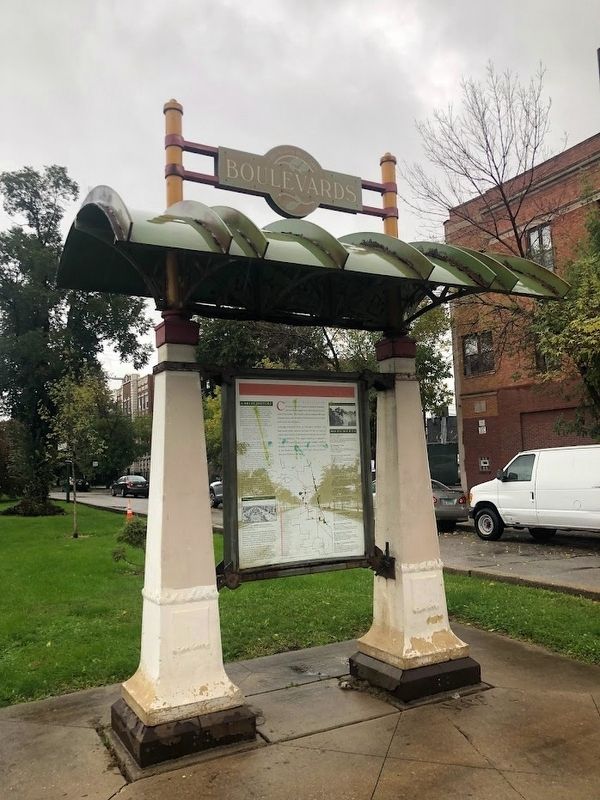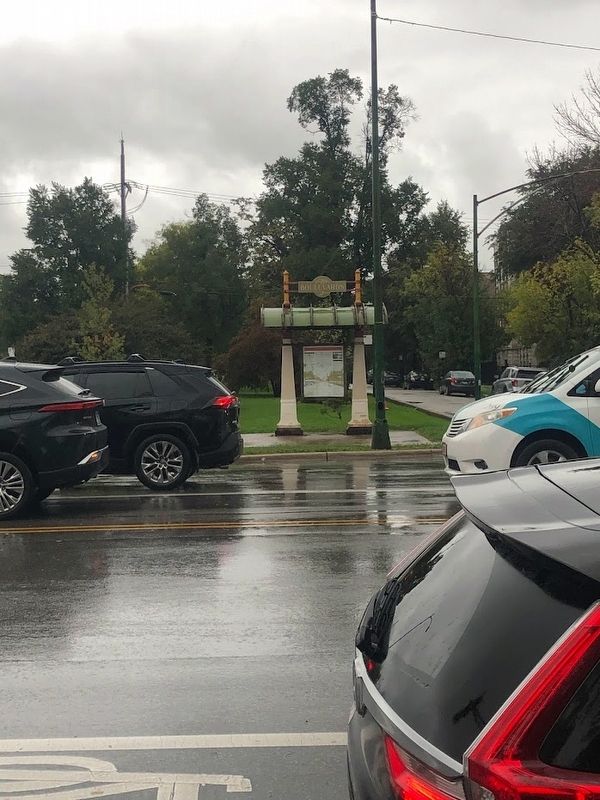Humboldt Park in Chicago in Cook County, Illinois — The American Midwest (Great Lakes)
The Boulevard System
Chicago’s Boulevards are one of the city’s most overlooked treasures, and one of the largest and oldest boulevard systems in the nation. The 28-mile system contains 540 acres of green space, and provides a link between seven inland parks and Lake Michigan.
Although originally built on Chicago's outskirts, the boulevards today encircle the heart of the city and are within three blocks of the homes of one out of every six Chicago residents. The longest boulevard segment is Dr. Martin Luther King, Jr. Drive (4.5 miles), while the shortest is Central Park (less than one mile). The widest is the Midway Plaisance (750 feet); the narrowest, Diversey Parkway (66 feet).
A Brief History
In 1837, when Chicago selected its motto Urbs in Horto ("City in a Garden"), there were very few parks here. This was not uncommon: New York City did not start building Central Park until the 1850s, and construction of Boston's "emerald necklace" did not begin until 30 years after that.
So, when Chicago developer John S Wright proposed a vast network of parks and boulevards with the hopes of encouraging development, he was suggesting something new:
Of these parks I have a vision. They are all improved and connected with a wide avenue extending to and along the Lake shore on the north and south, and so surrounding the city with a magnificent chain of parks and parkways that have not their equal in the World.
It took two decades for Wright's innovative idea to gain public support. The 1869 Illinois "parks bills" established three regional park commissions to create a unified system of parks linked by pleasure drives.
The South Commission hired Frederick Law Olmstead, America’s premier landscape architect, who styled landscapes with informal groupings of trees and meandering pathways. The West Commission's lead designer was William LeBaron Jenney, whose formal rows of trees complemented the geometric paths he planned. Later, Jens Jensen, founder of Prairie-style landscape architecture, created a more natural look for the west parks and boulevards using native plantings. Legal challenges precluded construction of the North Commission's design for Diversey Parkway.
Much of Chicago's boulevard system was constructed during the real estate boom of the late 19th century. As these boulevards were completed, they became popular recreational and social destinations. Chicagoans promenaded and rode horses and carriages along the smoothest roads of their era. As John Wright and others had hoped, the boulevard gradually attracted residential developers. The most magnificent mansions were built along Grand (now King Drive) and Drexel boulevards.
When Chicago held the 1893 World's Columbian Exposition in Jackson Park and along the Midway Plaisance, it showcased a grand park system that few American cities could match. Inspired by this display, Kansas City, Minneapolis, and Washington, D.C., initiated the development of their own park and parkway systems.
In the early 1930s, the three park commissions were consolidated to become the Chicago Park District. The Park District maintained the boulevards until 1959, when the responsibility was turned over to the City of Chicago. Today, the parks and boulevards remain a testament to the vision that helped establish Chicago as a national model.
Monuments
A • Drexel Fountain
1881, Henry Manger
One of the oldest in the city, this fountain honors Francis Drexel, a Philadelphia banker who donated the land for Drexel Boulevard.
B • Fountain of Time
1922, Lorado Taft
The masterpiece of one of Chicago's foremost sculptors, this depiction of the "Ages of Man" took 14 years to complete.
C • Carl von Linne Monument
1891, Johan Dyfverman
This monument depicts the Swedish botanist who originated the modern scientific classification system for plants and animals.
D • Masaryk Memorial
1949 Albin Polasek
This statue of the medieval knight, St. Wenceslaus
was dedicated to Thomas Masaryk, Czechoslovakia's first president and a former University of Chicago faculty member.
E • Victory Monument
1927, Leonard Crunelle
Dedicated to members of the Eighth Regiment of the Illinois National Guard (an African-American unit) who died in service during World War l. The "doughboy" was added in 1936.
F • Washington Memorial
1904, Daniel Chester French and Edward Clark Potter
This statue of George Washington at the time of the Revolutionary War is a duplicate of one in Paris.
G • Vietnam Veterans Marker
This marker and flag pole were commissioned by the Gage Park Civic Association in 1983.
H • McKinley Monument
1905, Charles J. Mulligan
This statue was installed in honor of President William McKinley, who was assassinated in 1901.
I • Marquette Monument
1926, Hermon Atkins MacNeil
Jacques Marquette, Louis Jolliet, and an Algonquin Indian are depicted as they explored the Illinois River Valley in 1673.
J • One Family-One World
1979, Sidney Murphy
This sculpture was designed by the winner of a local high school student design competition.
K • Independence Fountain
1902, Charles J. Mulligan
This fountain honors American youth and Independence Day. Four children are depicted celebrating the Fourth of July
L • Illinois Centennial Column
1918, Henry Bacon
This monument, which honored 100 years of Illinois statehood, was designed by the architect of the Lincoln Memorial Washington, D.C Evelyn Longman sculpted the eagle.
Topics and series. This historical marker is listed in these topic lists: Architecture • Arts, Letters, Music • Roads & Vehicles. In addition, it is included in the Jens Jensen series list. A significant historical year for this entry is 1869.
Location. 41° 54.621′ N, 87° 42.098′ W. Marker is in Chicago, Illinois, in Cook County. It is in Humboldt Park. Marker is on North Avenue near Humboldt Boulevard, on the right when traveling west. The marker faces North Avenue in the eastern parkway between the main Humboldt Boulevard and the local byway that runs parallel. Humboldt Park is across the street. Touch for map. Marker is in this post office area: Chicago IL 60647, United States of America. Touch for directions.
Other nearby markers. At least 8 other markers are within walking distance of this marker. Humboldt Park (here, next to this marker); L. Frank Baum (about 700 feet away, measured in a direct line); a different marker also named Humboldt Park (approx. ¼ mile away); a different marker also named Humboldt Park (approx. 0.3 miles away); Logan Square Boulevards (approx. 0.4 miles away); a different marker also named Logan Square Boulevards (approx. half a mile away); Jens Jensen (approx. 0.6 miles away); a different marker also named Logan Square Boulevards (approx. 0.7 miles away). Touch for a list and map of all markers in Chicago.
More about this marker. There appears to be the remnants of past graffiti on the marker, but the marker is otherwise readable. The marker is under a canopy; atop the canopy is a sign that says "Boulevards." The back of this Boulevards marker has a separate marker for Humboldt Park.
At least three other identical versions of this marker can be found on other parts of Chicago's boulevard system: one on Martin Luther King Drive on the city's south side; one in the Lincoln Park neighborhood on the north side; and one in Logan Square, about 1½ miles north of this location.
Also see . . . Biking the Boulevards with Geoffrey Baer. This production on WTTW-TV (Channel 11, Chicago's PBS station) explores the history of the Chicago boulevard system and includes a short video about Humboldt Boulevard
Excerpt: "Humboldt Boulevard marks the south end of the Logan Square Boulevards District. The district, which includes Humboldt Boulevard, Palmer Boulevard, Kedzie Boulevard, Logan Square, and Logan Boulevard, was named a National Historic District in 1985 and a Chicago landmark in 2005."(Submitted on October 17, 2023, by Sean Flynn of Oak Park, Illinois.)
Credits. This page was last revised on October 18, 2023. It was originally submitted on October 17, 2023, by Sean Flynn of Oak Park, Illinois. This page has been viewed 45 times since then and 8 times this year. Photos: 1, 2, 3. submitted on October 17, 2023, by Sean Flynn of Oak Park, Illinois. • Andrew Ruppenstein was the editor who published this page.


